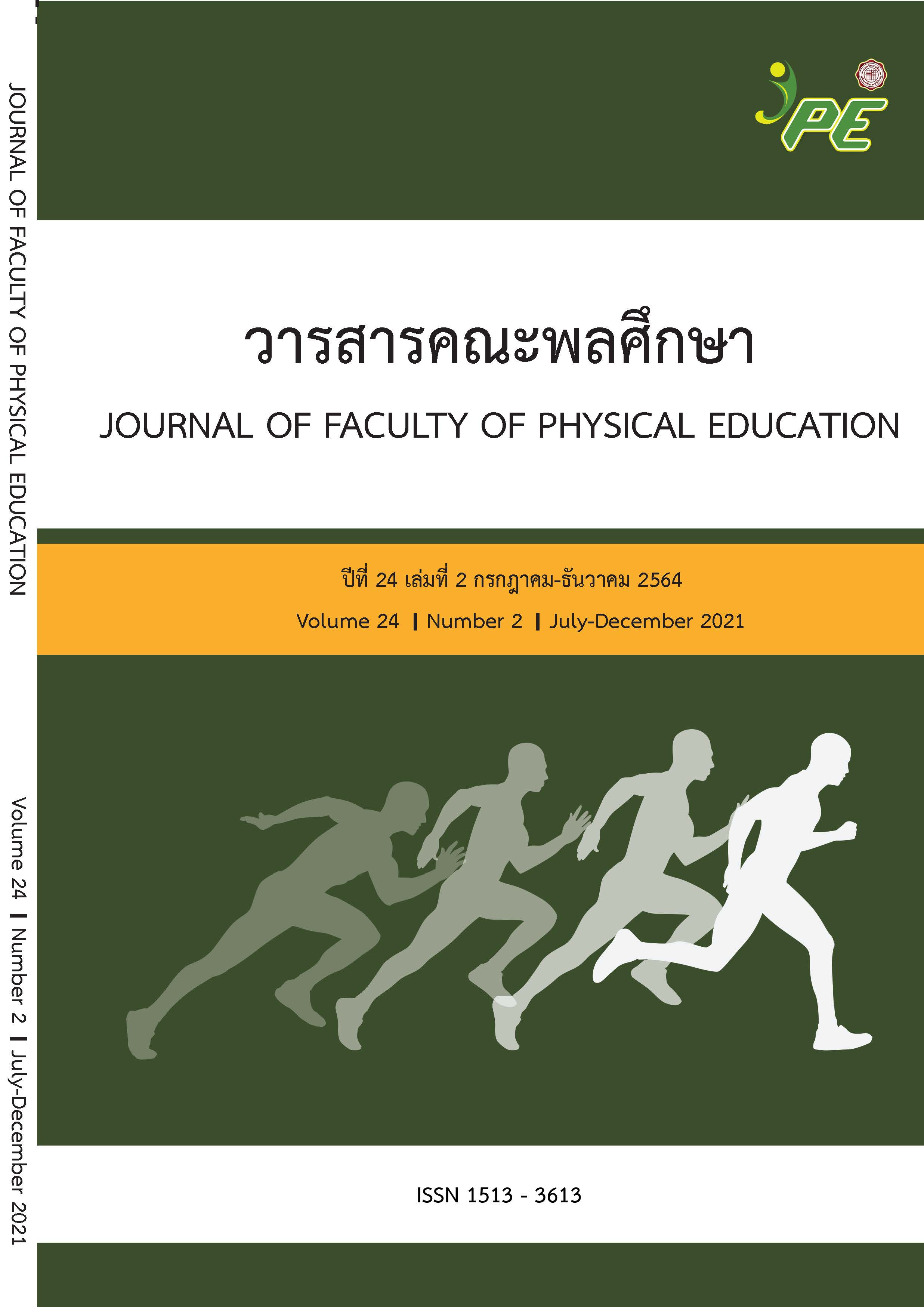THE EFFECT OF COLD-WATER IMMERSION AT HALF-TIME ON THE PHYSICAL FITNESS SOCCER PLAYERS OF LOEI RAJABHAT UNIVERSITY AFTER COMPETITION
Main Article Content
Abstract
Purpose: The purpose of this study was to investigate and compare the effects of cold water immersion
during half-time on the physical fitness of soccer players.
Methods: The sample consisted of 16 male soccer players of Loei Rajabhat University aged between 18
and 25 years. All participants were divided into two groups: the control group (n=8) and experimental group
(n=8). Both groups competed in a 90-minute soccer match, divided into 45 minutes in the first half and 45
minutes in the second half, with a 15-minute halftime break. Data were collected and results were statistically
analyzed using mean and standard deviation. Mean physical fitness was compared 24 hours after the game.
To determine the differences between the groups, a paired samples t-test the significance level .05
Results: Physical fitness in the agility of control group was significantly higher than pretest (12.94±0.78
seconds) and 24 hours after the competition (13.30±0.77 seconds) at the .05 level. Sprint time was
statistically significantly higher than pretest (5.93±0.39 s) and 24 hours after competition (6.42 s) at the .05
level. Maximal oxygen uptake of the control group was statistically significantly decreased before the test
(60.43±2.39 ml/kg/min-1) and 24 hours after the competition (58.71±1.60 ml/kg/min-1) at the .05 level. In
contrast, when compare leg strength, power of the leg muscles, agility, sprint and maximal oxygen
consumption in experimental group. There were no significant differences.
Conclusion: The method of immersion in cold water at halftime of football can slow down fatigue. This
ensures that physical performance in terms of agility, speed and maximum aerobic capacity does not
decrease, which is an alternative for rehabilitation of football players.
Article Details

This work is licensed under a Creative Commons Attribution-NonCommercial-NoDerivatives 4.0 International License.
Any articles and comments This journal is the opinion of the author. The Faculty of Physical Education doesn't always have to agree. Anyone wishing to publish or distribute a message must obtain direct permission from the author.
References
Bangsbo, J. (1994). The physiology of soccer--with special reference to intense intermittentexercise.
Acta physiologica Scandinavica. Supplementum, 619, 1-155.
Russell, M., Rees, G., Benton, D. & Kinglsey, M. (2011). An Exercise Protcol that Replicates Soccer
Match-Play. International Journal of Sports Medicine, 32, (7), 511-518.
Buchheit, M. (2012). Repeated-sprint performance in team sport players: associations withmeasures of
aerobic fitness, metabolic control and locomotor function. InternationalJournal of Sports Medicine, 33, (3),
-239.
Mohr, M., Mujika, I., Santisteban, J., Randers, M. B., Bischoff, R., Solano, R., Hewitt,A.,Zubillaga, A.,
Peltola, E. & Krustrup, P. (2010). Examination of fatigue developmentin elite soccer in a hot environment:
a multi-experimental approach. ScandinavianJournal of Medicine & Science in Sports, 20, (3), 125-132.
Gregson, W., Drust, B., Atkinson, G. & Di Salvo, V. (2010). Match-to-match variability ofhigh speed
activities in premier league soccer. International Journal of SportsMedicine, 31, (4), 237-242.
Buchheit, M., Hammond, K., Bourdon, P. C., Simpson, B. M., Garvican-Lewis, L. A., Schmidt,W. F.,
Gore, C. J. & Aughey, R. J. (2015). Relative Match Intensities at High Altitudein Highly-Trained Young
Soccer Players (ISA3600). Journal of Sports Science &Medicine, 14, (1), 98-102.
Mohr, M. & Krustrup, P. (2013). Heat Stress Impairs Repeated Jump Ability After Competitive Elite
Soccer Games. Journal of Strength and Conditioning Research, 27, (3), 683-689.
Nassis, G. P. (2013). Effect of altitude on football performance: Analysis of the 2010 FIFAWorld Cup
data. Journal of Strength & Conditioning Research, 27, (3), 703-707.
Bleakley, C., McDonough, S., Gardner, E., Baxter, G.D., Hopkins, J.T., & Davison, G.W. (2012). Coldwater
immersion (cryotherapy) for preventing and treating muscle soreness after exercise. Cochrane
Database Syst Rev. 15(2). CD008262.
Bieuzen, F., Bleakley, C.M., and Costello, J.T. (2013). Contrast Water Therapy and Exercise Induced
Muscle Damage: A Systematic Review and Meta-Analysis. PLoS One, 8(4): e62356.
Hohenauer E, Taeymans J, Baeyens J-P, Clarys P, Clijsen R (2015) The Effect of Post-Exercise
Cryotherapy on Recovery Characteristics: A Systematic Review and Meta-Analysis. PLoS ONE 10(9):
e0139028. doi:10.1371.
Vaile, J., Halson, S., Gill, N. and Dawson, B. (2008). Effect of cold water immersion onrepeat cycling
performance and thermoregulation in the heat. Journal of SportsScience. March; 26(5) : 431-440.
Marsh, D., & Sleivirt, G. (1999). Effect of precooling on high intensity cycling performance.Br J Sport
Med, 33(6)
Gonzalez-Alonso, J., Teller, C., Andersen, S. L., Jensen, F. B., Hyldig, T. & Nielsen, B. (1999). Influence
of body temperature on the development of fatigue during prolonged exercise in the heat. Journal of Applied
Physiology (1985), 86, (3), 1032-9.
Ascensao, A. (2011). Effects of cold water immersion on the recovery of physical Performance and
muscle damage following a one-off soccer match. Journal of Sports Sciences, February 1st 2011; 29(3):
–225.
Wilcock, I. (2006). The effect of water immersion, active recovery and passive recovery on repeated
bouts of explosive exercise and blood plasma. Master of Health Science:Auckland University of Technology.


